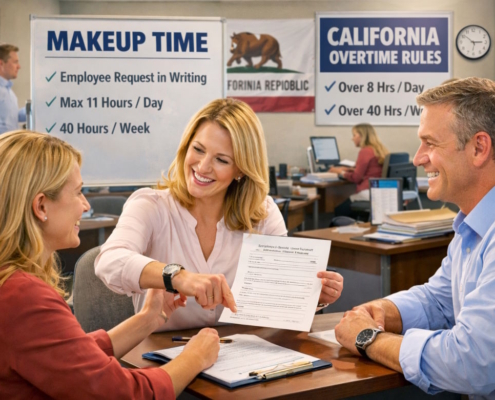Understanding California Meal and Rest Break Laws
In California, workers are granted some of the strongest protections when it comes to meal and rest breaks. The state recognizes the importance of allowing employees time to recharge during their workday. These rights are not just suggestions but are enforced through specific regulations outlined in the California Labor Code. Employers who fail to comply with these laws risk penalties and potential legal consequences.
California law provides most employees with the right to:
- An unpaid 30-minute meal period if they work more than 5 hours
- At least one paid ten-minute rest break if they work at least 3.5 hours in a day
- A second paid ten-minute break if they work at least 6 hours
Employers must provide all non-exempt employees the opportunity to have a thirty-minute meal period if they work more than five (5) hours.
An employee may:
- Agree with the employer not to take a meal break if the employee works six (6) hours or less
- Be entitled to two thirty (30) minute meal breaks if working for more than ten (10) hours
- Waive the second meal break if working less than twelve (12) hours and the first meal break was taken
Employers must relieve employees of all duties and permit a reasonable opportunity to take an uninterrupted meal break of 30 minutes. Employees use their breaks to handle personal business such as meals, errands, or any other activity of their choice. Employers cannot:
- Prevent employees from taking meal breaks
- Create incentives to skip breaks
- Encourage a culture of missed breaks
California rest and meal break law is not just an opportunity to eat a quick snack; it is a mandatory rest period required by California labor laws.
What Rights Do Employees Have During Meal Breaks?
During a meal break, employees are granted a complete reprieve from work responsibilities. This time is intended for rest and personal use, without interruptions from supervisors or tasks. The law protects this period to ensure that employees can truly disengage and refresh themselves.
- Employees avoid working or being interrupted during the 30-minute break
- Employees may voluntarily work through their meal break, but employers must still offer it
- Employees may take meal breaks off company grounds
- Employers relieve employees of all duties and permit personal use of this time
“On-duty” meal periods:
- Employers may permit them only if the job prevents relief from duty
- Employers and employees must agree upon them in writing
- Employers must pay for on-duty breaks
- Employers generally do not require them to be on-premises unless exceptions apply
What Are the Timing Rules and Waiver Options for Meal Breaks?
Meal breaks are a crucial component of labor rights in California, and their timing is governed by clear and specific regulations. Employees and employers alike must understand when to take these breaks, how they may waive them, and what responsibilities they must fulfill to stay compliant with the law. Understanding these rules helps ensure lawful and fair treatment in the workplace.
Meal break rules:
- Must be provided before the last hour of the shift
- Can be waived if the shift is no longer than 6 hours and both parties agree
- A second 30-minute break is required for shifts over 10 hours
- Second meal break can be waived if the first was taken and the total shift does not exceed 12 hours
- Employees must clock out to take their meal break
- Waiving both breaks in one day is not allowed
- Employers must not discourage or incentivize skipping breaks
When Are Employees Entitled to Rest Breaks?
Rest breaks are essential to ensure that employees remain alert, healthy, and productive throughout the workday. California law mandates that non-exempt employees receive rest breaks at specific intervals based on the duration of their shift. These breaks must be duty-free and are considered paid time.
Employers must permit:
- One 10-minute rest break if the employee works at least 3.5 hours
- Two rest breaks for shifts over 6 hours
- Three rest breaks for shifts over 10 hours
Additional rest break rules:
- Must be taken in the middle of each 4-hour work period
- Must be uninterrupted and duty-free
- Employees may leave the premises during their rest breaks
What Conditions Must Be Met During Rest Breaks?
The quality and accessibility of rest breaks are just as important as their timing. Employers must ensure that employees are genuinely relieved from work responsibilities and can enjoy their break in a suitable environment. The following outlines what is required during rest breaks:
During rest breaks:
- Employees must not be required to stay on premises
- Cannot be required to carry radios, check phones, or perform any work duties
- Breaks are paid and counted as time worked
- Employers must provide a resting area separate from toilet rooms
- Employees can voluntarily skip breaks but cannot be pressured to do so
In some job roles like security or remote positions, on-duty meal breaks are permitted under specific conditions with mutual agreement.
What Happens If Employers Violate Break Laws?
Failing to comply with California’s meal and rest break laws can result in significant financial and legal consequences for employers. The law is designed to protect employees, and there are specific penalties for noncompliance:
If an employer fails to provide compliant breaks:
- They must pay a “premium wage” of one extra hour of regular pay per day of violation
- If both rest and meal breaks are missed, two hours of regular pay is owed
- Employees can file a wage claim with California’s Division of Labor Standards Enforcement (DLSE)
- Claims must be filed within 3 years from the date of the violation
Employers who retaliate against employees for asserting break rights or filing claims violate the law and risk facing additional penalties.
What Are the Requirements for Recordkeeping and Compliance?
Maintaining accurate records is a critical component of break law compliance. Employers have specific obligations related to documenting break periods, and doing so correctly can help resolve disputes and avoid legal penalties:
- Employers must keep time records of provided meal periods for non-exempt employees
- Failure to maintain records presumes that meal breaks were not provided
- Tracking of rest breaks is not required but may help ensure compliance
- Timekeeping systems can identify and resolve break compliance issues
Who Is Exempt from Standard Break Laws and What Are the Special Cases?
While many workers are covered by standard meal and rest break laws, there are notable exceptions. Understanding who qualifies as an exempt employee or falls under industry-specific rules is key to proper legal compliance:
- Exempt employees are entitled to meal but not rest breaks
- Must earn at least twice the state minimum wage and perform creative or managerial duties
- Independent contractors are not covered under these laws
- Unionized employees may have different break schedules via collective bargaining agreements
- Industries like healthcare, construction, and the film industry may have specific rules
Some attorneys specialize in PAGA claims and seek out break law violations to pursue enforcement.
What Are the Best Practices for Employers to Ensure Compliance?
Employers must foster a culture of respect for employee break time and ensure full compliance with state regulations. The following practices summarize what is needed to maintain lawful and healthy workplace environments:
To stay compliant, employers must:
- Relieve employees of all duties during breaks
- Allow complete control over break activities
- Provide reasonable opportunities for uninterrupted breaks
- Respect employee autonomy over where and how breaks are taken
Employers must not:
- Discourage or interrupt breaks
- Offer incentives to skip breaks
- Praise or reward skipping breaks
Breaks cannot be forced, but must be available. Employees can revoke meal break waivers at any time. Legal consultation is advised for employers with unique industry requirements or for resolving disputes effectively.
Proactive compliance protects businesses from legal liability and promotes a positive workplace culture.































